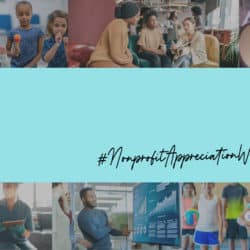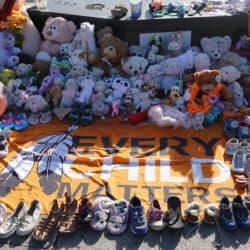This week: IWD in the time of COVID, the WE controversy resurfaces, a more equitable approach to the vaccine rollout, and the sector’s asks in the federal budget.
“Choose to challenge” on IWD
Last International Women’s Day, the director-general of the World Health Organization (WHO) tweeted that the world had reached a milestone of 100,000 COVID-19 infections. Now we’re at nearly 116 million. Almost 2.6 million have died.
The sector is well aware that it’s women who’ve been at the front lines of this crisis, and women who’ve born the brunt of ever-deepening inequities and hardship, prompting terms such as “she-cession“ and “shadow pandemic“ and a flurry of damning articles and reports.
With “Choose to Challenge” the global theme of this year’s IWD, the Canadian Women’s Foundation has identified three areas of action that require investment – unpaid care, including child and elder care; under-compensated work; and gender-based violence – to “challenge systemic inequities that pre-dated and came to a head with the virus” and move Canada toward gender justice. “Women-serving and equity-seeking collectives and organizations are vital civic engagement stalwarts, and they need to survive this trying time,” says CEO Paulette Senior.
Yesterday, the federal government announced a task force on women in the economy “to advance gender equity and address systemic barriers and inequities faced by women.” Its members, 18 women from diverse sectors and backgrounds – including Maya Roy, CEO of YWCA Canada; Jocelyn Formsma, ED of the National Association of Friendship Centres; and Armine Yalnizyan, Atkinson Foundation fellow on the future of workers – “will advise the government on a feminist, intersectional action plan that addresses issues of gender equality in the wake of the pandemic.”
Asked by the Toronto Star if the task force’s announcement is late, given that the budget will likely be presented next month, a spokesperson for Finance Minister/Deputy Prime Minister Chrystia Freeland said, “Since January, [Freeland] has been meeting with Canadians from diverse regions, sectors and backgrounds – very much including women – to discuss how best we can make investments in Budget 2021 and grow our economy during the recovery from the pandemic.”
The WE’s gambit
In a video testimony to the House of Commons ethics committee last week, Reed Cowan, an American journalist and former WE Charity donor, described the emotional impact of learning from a Bloomberg Businessweek investigation that schools built in Kenya with funds raised in honour of his four-year-old son, who died in a swing-set accident, bore the name of a different donor.
Such a revelation felt like “returning to my son’s grave to find it broken open, defiled and empty,” he said, especially when he read of jokes that plaques at the donor-funded schools were so frequently swapped they should be attached with Velcro.
Cowan called on everyone who’d ever had a connection with WE, from Prime Minister Justin Trudeau to Oprah Winfrey and the Dalai Lama, to come forward by March 8 and vouch for the charity if the Bloomberg allegations were false.
Canadian media outlets have been posting regular updates as the WE story evolves, including a letter from the Kielburgers’ lawyer to the ethics committee about a new call by New Democrat MP Charlie Angus for the brothers to testify. In a Fifth Estate interview last month, the Kielburgers said they felt like “political roadkill.”
Long-term-care houses of horror
Described as “houses of horror” in a November 2020 Toronto Life article, Canada’s long-term-care (LTC) homes continue to generate a flurry of media attention and scholarly research.
Survey results of 2,005 Canadians published by the National Institute on Ageing (NIA) and the Canadian Medical Association (CMA) last week show that 81% of respondents, and 92% of respondents 65 and over, think the LTC crisis existed long before the pandemic.
In Alberta, Ontario, Quebec, Saskatchewan, and Manitoba, nearly 100% of senior respondents said “they will do everything they can to avoid moving into an LTC home.” A new Long Term Care COVID-19 Tracker, updated twice a week, shows the wisdom of their resistance, province by province. As of March 5, 2021, the NIA had tracked 14,596 LTC-home deaths across the country.
According to an article in The Lancet, 80% of deaths in Canada’s first wave occurred in LTC homes – “the worst record among wealthy nations for COVID-19-related deaths” – and our “national disgrace” has continued to dog us into the second.
Vaccine inequity for migrant workers
Issues surrounding migration are getting more and more airtime as vaccination rollouts raise tough questions about equity and who gets access to shots.
From PEI’s Cooper Institute to the Yukon Federation of Labour, advocates are pushing for temporary foreign workers (TFWs) to be included in vaccine rollouts. Hundreds of organizations recently signed the Vaccines for All open letter calling on provincial and federal governments to recognize that these essential workers suffer from some of the highest COVID rates but “have been excluded from services and protections.” A June 2020 Migrant Workers Alliance for Change report highlighted conditions facing TFWs, painting a picture of sketchy labour practices, racism, abuse, and “inhumane” housing conditions.
Robyn Bunn, a member of Radical Action With Migrants in Agriculture (RAMA), based in BC’s Okanagan Valley, told Canada’s National Observer that because of such conditions, migrant workers have been contracting the virus in Canada, not bringing it into the country. Citing examples such as the three Mexican workers who died on southwestern Ontario farms, she said, “We’re just really urging the government this year to be proactive and take some steps to protect people as they come in.”
CTV News delved further into this issue, featuring interviews with Jhay Deluca, a migrant care-worker leader, and Syed Hussan, executive director of the Migrant Workers Alliance for Change.
Some groups, such as Canadian Doctors for Medicare, are taking matters into their own hands, administering doses without requiring health cards and giving people the option of providing an alias, CBC New reports.
The Ontario Nonprofit Network (ONN) has published a “COVID vaccination page,” providing resources and suggestions for how the sector can be “a vital partner” in ensuring an equitable and effective vaccination rollout. They list several non-profits currently acting as vaccination hubs, including the YMCA and the Wabano Centre for Aboriginal Health.
Green makeover
Interest in responsible investing and cleantech stocks continues to gain momentum.
TMX, the parent company of the Toronto Stock Exchange (TSX), this month launched an ESG trading platform (where environmental, social, and governance factors are used to screen investments), while the Alberta government created an ESG secretariat.
With an interest in “upping their game,” Alberta seems to be hoping for a bit of a makeover. “We really think we don’t get a fair shake when it comes to many – especially European – investors, who hear only the negative side of the oil sands,” Premier Jason Kenney told The Globe and Mail.
Meanwhile, a hydrogen fuel-cell company in Chilliwack, BC – Loop Energy – has just come off a $100-million IPO on the TSX. The firm was started by two guys in a beat-up pickup truck 20 years ago, according to the Abbotsford News.
In other financial news, Indigenous entrepreneurs will receive $25 million in investment from the world’s first Indigenous impact fund, the Raven Indigenous Impact Fund, with capital commitments provided by a network of 38 investors across the US and Canada.
With hurdles such as resource gaps and systemic racism experienced by many Indigenous entrepreneurs, the Indigenous intermediary launched the fund “to be part of this decolonization journey through finance,” said Paul Lacerte, managing partner of Raven Indigenous Capital Partners, in their announcement of the funding.
In addition, the Raven Indigenous Impact Foundation (RIIF) announced a new partnership with the World Diabetes Foundation to create “an innovative model for designing and financing diabetes interventions in Canada and around the world.” (The Philanthropist will publish a more in-depth report on this project later in the spring.)
Mapping the eco-future
In a country as ecologically diverse as Canada, “nature conservation often means making tough decisions,” writes Dan Kraus, national conservation biologist with the Nature Conservancy of Canada (NCC). To that end, the NCC has created a map to pinpoint areas in the more populated southern regions “where nature has been the most impacted and where conservation efforts are most urgently needed.”
The NCC has assessed 77 ecological regions, ranking them according to “total biodiversity and total threat.” Nine, including the Lake Erie Lowland (home of the GTA) and Eastern Vancouver Island, are currently in crisis. To find out more, visit the NCC project website.
The Weston Family Foundation announced plans to help another imperilled region – the prairie grasslands. Five organizations, including the NCC, Ducks Unlimited Canada, and the Saskatchewan Stock Growers Foundation, will share nearly $25 million in grants over the next five years to collaborate in the Weston Family Prairie Grasslands Initiative – “one of the largest prairie grasslands conservation efforts in Canadian history,” they noted in a press release.
For Arctic regions, help is coming in the form of SmartICE, described as “the world’s first climate change adaptation tool to integrate traditional knowledge of sea ice with advanced data acquisition and remote monitoring technology.”
But rapid warming in regions such as Nunatsiavut is preventing the Arctic Inspiration Prize–winning company from doing its work. By late January, temperatures were 20 degrees warmer than usual. Rex Holwell, SmartICE’s northern production and regional operations lead, was still waiting to set up his sensors. “Last year was really strange for how late the ice freeze was and this year is even stranger,” he told Up Here magazine.
The gift of Indigenous-led conservation
Frosty relations with our neighbours south of the border have also been thawing, and not just because of heartwarming Bernie Sanders mitten memes.
President Joseph Biden and Prime Minister Justin Trudeau earned accolades from the Indigenous Leadership Initiative for their first joint statement, in which they committed to partnering with Indigenous-led conservation efforts.
“The forces of colonialism are weakening as our Nations are re-building, setting the stage for a brighter shared future,” director Valérie Courtois wrote on the Indigenous Leadership Initiative website.
Courtois noted Indigenous-led programs such as Guardians and Indigenous Protected and Conserved Areas, describing them as “a gift to the world.”
Equitable recovery
First Policy Response and TVO have collaborated to raise awareness about the importance of equity in Canada’s economic recovery through a series of columns and panel discussions.
In Equity, Economic Recovery and COVID-19, panellists spoke of the need for a “bottom-up” rather than “top-down” approach to rebuilding. Nakema Rae McManamna, director of policy and research for the Canadian Black Policy Network, noted, “We are the ones on the front lines doing this work, and as a result, I think we are the ones who should be involved in the policy solutions.”
Arts orgs wait, and wait, for relief funding
With the federal budget due this month, sector organizations have been busy making submissions about spending priorities.
Organizations in the hard-hit arts community, such as the Canadian Association for the Performing Arts (CAPACOA), requested an additional $540 million to continue relief funding, predicting the recovery phase for live performance could last until spring 2023. For a thread on other submissions collected by The Philanthropist, click here.
Yet there’s some pre-budget good news in arts funding: Canadian Heritage and the Canada Council for the Arts announced $181.5 million in funding for the live arts and music sectors in 2021/2022 to “support the planning and presentation of COVID-19-safe events in the arts and music sectors – including both live and digital – and provide work opportunities in these sectors.” Artists and arts organizations can submit grant proposals here.
Also this week:
Take a walk. Park People, a national charity focused on the power of parks that produces the annual Canadian City Parks Report, has distilled its pandemic learnings about open space in a wish list for 2021, including the expansion of parks beyond their boundaries.
Diversity deficit. A new episode of the Toronto Star podcast This Matters features a discussion about the lack of diversity in Canadian non-profits. The segment is based on the Statistics Canada survey on board diversity in Canada’s non-profit sector, spearheaded by Senator Ratna Omidvar in The Philanthropist in June 2020.
Also, the latest episode of Omidvar’s podcast, Moving the Needle on Wicked Problems, explores the effect of COVID on migration. “It’s one issue that has not surfaced as prominently as it maybe should,” considering the sheer number of people affected, she says.
Women and giving. Funding the Future: Feminist Philanthropy in Practice is a post-IWD special edition of the #WebinarWednesdays series, which is hosted by Philanthropic Foundations Canada, Community Foundations of Canada, Environment Funders Canada, The Circle on Philanthropy and Aboriginal Peoples, and the Equality Fund.
Common cause. The latest study from Mount Royal University’s Institute for Community Prosperity focuses on an issue facing a lot of non-profits these days: Merging for Good: A Case-Based Effective Framework for Supporting Nonprofit Amalgamations.
The politics of donations. Women of Colour Challenging is the latest in Ryerson University’s webinar series Generous Futures: Power and Politics in Charitable Giving. This instalment explores the struggles, politics, and possibilities within the charitable sector.


